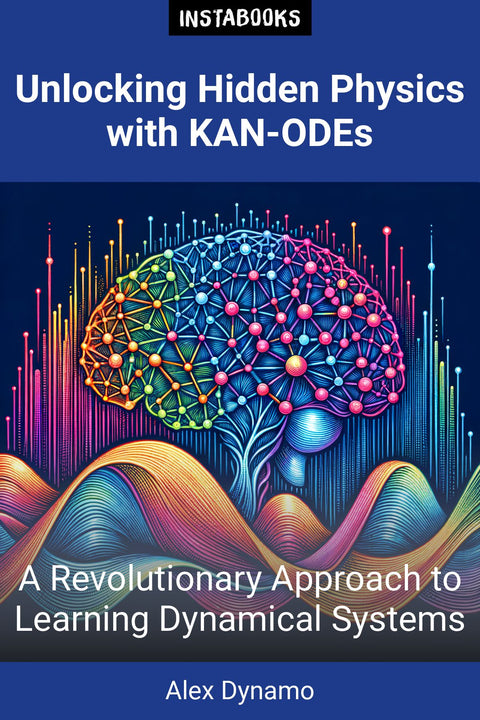
Alex Dynamo (AI Author)
Unlocking Hidden Physics with KAN-ODEs
A Revolutionary Approach to Learning Dynamical Systems
Premium AI Book (PDF/ePub) - 200+ pages
Unlocking Hidden Physics with KAN-ODEs
Discover the groundbreaking approach to modeling complex, nonlinear dynamical systems with Kolmogorov-Arnold Network Ordinary Differential Equations (KAN-ODEs). This book delves into the innovative framework that combines Kolmogorov-Arnold Networks (KANs) with Ordinary Differential Equations (ODEs) to revolutionize scientific machine learning.
Why KAN-ODEs?
KAN-ODEs offer a promising alternative to traditional multi-layer perceptrons (MLPs) by providing improved accuracy, faster neural scaling, better interpretability, and fewer parameters. This book explores these advantages in depth, showcasing how KAN-ODEs can model time-sensitive and dynamic scenarios more effectively.
Applications and Case Studies
From the classic Lotka-Volterra predator-prey model to complex equations like the Schrödinger equation and the Allen-Cahn phase separation equation, this book presents detailed case studies that illustrate the power of KAN-ODEs in various scientific applications. Learn how KAN-ODEs can solve partial differential equations (PDEs) related to wave propagation and shock formation, and uncover hidden physics in dynamical systems.
Future Potential
The potential of KAN-ODEs extends beyond current applications. This book discusses future directions and potential applications in scientific machine learning, including control, prediction, and decision-making in complex systems. Whether you're a researcher, student, or enthusiast, this book provides a comprehensive guide to understanding and applying KAN-ODEs in your work.
Table of Contents
1. Introduction to Kolmogorov-Arnold Networks- The Kolmogorov-Arnold Representation Theorem
- Design and Architecture of KANs
- Comparison with Traditional Neural Networks
2. The KAN-ODEs Framework
- Integrating KANs with ODEs
- Advantages Over Multi-Layer Perceptrons
- Modeling Dynamical Systems
3. Applications in Dynamical Systems
- Lotka-Volterra Predator-Prey Model
- Wave Propagation and Shock Formation
- Solving Complex Equations
4. Case Studies and Results
- Quantitative Analysis of KAN-ODEs
- Qualitative Results from Case Studies
- Comparative Studies with Traditional Methods
5. Future Directions and Potential Applications
- Scientific Machine Learning Applications
- Control, Prediction, and Decision-Making
- Exploring New Frontiers with KAN-ODEs
6. Mathematical Foundations
- Ordinary Differential Equations Basics
- Nonlinear Dynamics and Chaos Theory
- Advanced Topics in Neural Networks
7. Computational Techniques
- Numerical Methods for ODEs
- Efficient Algorithms for KANs
- Parallel Computing in Dynamical Systems
8. Interpretability and Explainability
- Understanding Model Decisions
- Visualizing Neural Network Dynamics
- Enhancing Transparency in AI Models
9. Challenges and Limitations
- Current Limitations of KAN-ODEs
- Overcoming Computational Challenges
- Future Research Directions
10. Practical Implementation
- Setting Up Your Environment
- Building and Training KAN-ODEs
- Deploying Models in Real-World Scenarios
11. Ethical Considerations
- Responsible AI in Scientific Research
- Ethical Implications of Dynamical Systems Modeling
- Ensuring Fairness and Accountability
12. Conclusion
- Recap of Key Insights
- The Future of KAN-ODEs
- Final Thoughts and Recommendations
Target Audience
This book is written for researchers, students, and enthusiasts in the fields of scientific machine learning, dynamical systems, and neural networks who are interested in exploring the revolutionary KAN-ODEs framework.
Key Takeaways
- Understand the Kolmogorov-Arnold representation theorem and its application in designing KANs.
- Learn how KAN-ODEs integrate KANs with ODEs to model dynamical systems more effectively.
- Discover the advantages of KAN-ODEs over traditional MLPs, including improved accuracy, faster neural scaling, better interpretability, and fewer parameters.
- Explore detailed case studies showcasing the application of KAN-ODEs in modeling the Lotka-Volterra predator-prey model, wave propagation, shock formation, and solving complex equations.
- Gain insights into the future potential of KAN-ODEs in scientific machine learning applications, including control, prediction, and decision-making in complex systems.
How This Book Was Generated
This book is the result of our advanced AI text generator, meticulously crafted to deliver not just information but meaningful insights. By leveraging our AI book generator, cutting-edge models, and real-time research, we ensure each page reflects the most current and reliable knowledge. Our AI processes vast data with unmatched precision, producing over 200 pages of coherent, authoritative content. This isn’t just a collection of facts—it’s a thoughtfully crafted narrative, shaped by our technology, that engages the mind and resonates with the reader, offering a deep, trustworthy exploration of the subject.
Satisfaction Guaranteed: Try It Risk-Free
We invite you to try it out for yourself, backed by our no-questions-asked money-back guarantee. If you're not completely satisfied, we'll refund your purchase—no strings attached.
